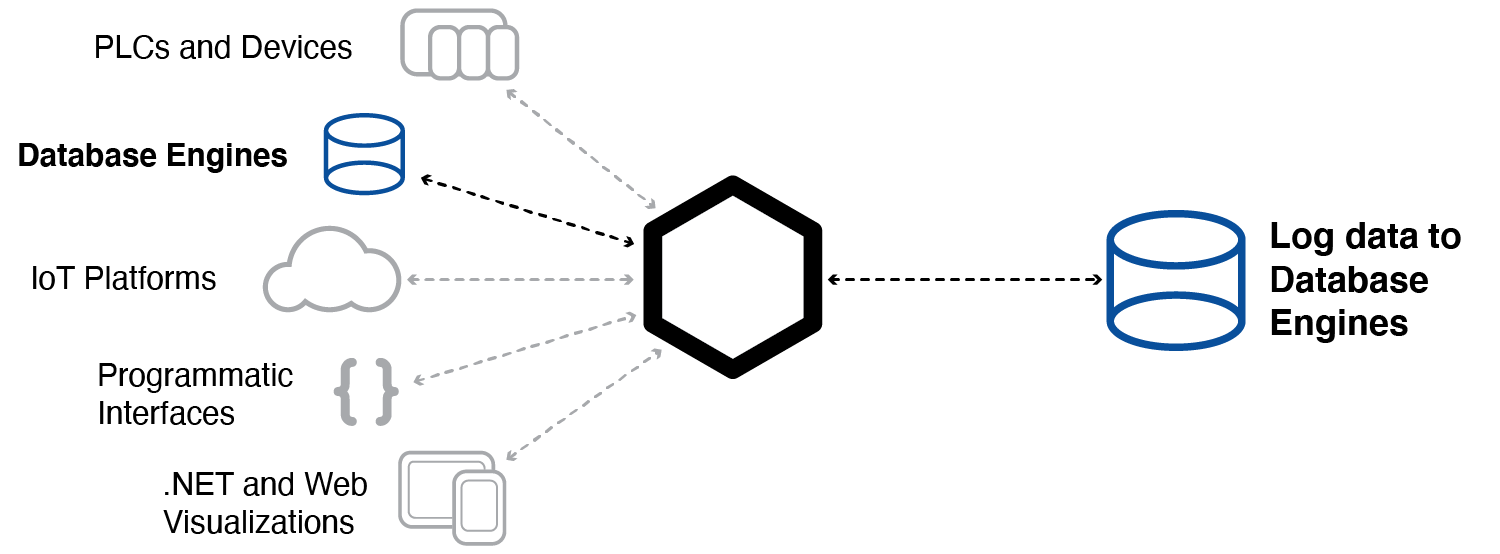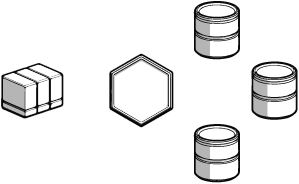Lightning Fast Data Logging
The OAS Data Historian software allows you to log data at high speed to most database platforms, and even simultaneously to CSV files. Your data is always accessible and never locked behind proprietary formats. Sources of data can be any system or device connected to the OAS server, including your own application data through any of the OAS SDKs and APIs.
a server-based, highly-scalable, network platform that enables the transport and transformation of your data
Data HistorianAchieve fault-tolerant logging, zero data loss, and multi-destination storage with our high-performance Store and Forward technology.
Visualization ToolsBuild Visualizations, User Interfaces, and server configuration interfaces for .NET, web technologies, native iOS and Android mobile apps
Device & Data ConnectorsThe OAS Platform provides rapid communications and connectivity to a wide variety of PLCs, devices, and databases.
IoT ConnectorsConnect to cloud-base IoT gateways such as AWS, Azure IoT Hub, Azure Event Hubs, Kafka, and more.
Alarm Logging & NotificationCapture events on each data point, log to open formats for historical analysis and archiving, and trigger real time notifications
SDKs & APIsExplore a wide variety of Developer Tools and APIs to allow you to create applications and system integrations to execute in any environment.
Networking FeaturesOpen Automation Software implements edge computing with a Distributed Network Architecture.
Download a fully functional trial of Open Automation SoftwareKey Features & Benefits
Industry 4.0 Data Sources
Modbus, Allen Bradley PLCs, Siemens S7 Controllers, OPC UA, OPC DA, MQTT, Sparkplug B, MTConnect, AWS IoT Core, Kafka, .NET, REST Clients, Databases
Open Format Data Logging
Once data is logged, you are free to access it with your own or 3rd party tools for reporting or analytics
Feedback Verification
Communications handshaking can provide confirmation to controllers data has been successfully logged.
Automated Setup
Set up data logging for all of your data using One-Click Database
Data Accuracy
Data from each source is processed on-premise in a first-in, first-out (FIFO) manner. This approach ensures that all received data is preserved, not just the most recent value. Maintaining full data accuracy is essential for all applications that depend on the data that is logged.
High Speed & Scalability
Log to more than 10,000 separate tables per server up to 100 nanosecond resolution. Log up to 2 million values per second to local or remote SQL Server.
Zero Data Loss
Our historian database software buffers data in real time. If communications is lost to the destination database, or if the destination is unavailable for any reason, no data is lost. As soon as communications are reestablished, all data is transferred at high speed.
Extensive Database Support
Our SCADA data historian supports a wide range of database platforms, including: MS SQL Server, SQL Azure, Oracle, MySQL, PostgreSQL, MongoDB, MariaDB, Cassandra, SQLite, InfluxDB, Amazon Aurora, Amazon RDS, Amazon Redshift, Google Firebase, MS Access (Windows only), and CSV Files.
Custom Logging Behaviors
You have unlimited options for how and when you want data to be logged. Data Historian supports both continuous time series data, and event-based data recording. Logging can be enabled and disabled based on other conditions or calculations within the system, as well as a unique Snapshot Logging option for logging data leading up to an event, allowing you to analyze data that may have led up to the event itself.

Common Questions
What databases work with the OAS Data Historian?
The OAS Data Historian supports a variety of databases, including MS SQL Server, Oracle, MySQL, MongoDB, InfluxDB, and even CSV files.
Does the Data Historian prevent data loss during network outages?
Yes, it has a Store and Forward feature that buffers data, so you won’t lose anything even if there’s a connection issue.
Can I customize how data is logged?
Yes, you can set up logging based on time, events, or custom conditions, and use Snapshot Logging to capture data before an event happens.
Learn how thousands of customers are using the OAS Product Platform around the globe to achieve truly open industrial automation
24/7/365
Support
Technical support available by phone, chat, and email
30+ Years
Experience
Product efficacy, market testing, and reliability
Used in 10K+
Data Servers
OAS is used in thousands of businesses worldwide
OAS Platform Features
Cross-Platform Support
The OAS Platform supports multiple operating systems and deployment options including Windows, Linux, Docker Containers, and can even run on low footprint devices such as a Raspberry PI 4.
Networking
OAS is an edge solution that offers flexible networking options for standalone installations, multi-tenant data aggregation, and even secure unidirectional data transport.
Programmatic Setup
Utilize our .NET SDK or REST API for flexible and automated setup, ensuring full integration with your asset management software. You can also import and export CSV files, which helps you work with Excel and third-party applications.
Calculations, Time On, Counts, and Totals
Merge data from various controllers and additional data sources while performing real-time computations and logic processing, all without the need for coding. Monitor the duration of activities for specific points and the frequency of their transitions over a defined period. Aggregate analog values both daily and over the entire timeline.
See How We Compare
The initial cost of OAS is far less than our competitors – but the savings don’t stop there. We work with OEMS and System Integrators to provide perpetual licenses with quantity discounts with flexible tag pricing and unlimited client connections.
No Questions Left Unanswered
We make getting started with OAS easy - Follow this step-by-step introduction to using the Open Automation Software platform, from selecting your data sources, product features, and data destinations.
Getting Started with Data Historian
Getting Started - Download, Setup, and Support
Step-by-step introduction to using the Open Automation Software platform
How to manually add and define Tags using the Configure OAS application.
Familiarize yourself with the following steps to setup data logging.
One Click Database - Automatically Setup Data Logging
Watch our demo on how to log 1 millisecond data from a controller.
Learn how OAS support data logging with resolution to 100 nanoseconds.
High Speed Logging from .NET with 100 nanosecond resolution
Learn how OAS support data logging with resolution to 100 nanoseconds.
.NET Programmatic Data Logging Setup
Learn about programmatically modifying data logging groups.
More about the 3 key networking methods included with licenses.
How to quickly access options and make custom changes.
How to active and manage OAS license.














